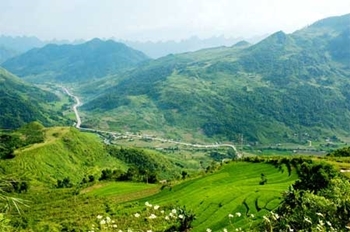Ba Be Lake
 Ba Be Lake is situated 230km from Hanoi and 80km to the Northwest of Bac Kan town. The lake is the biggest natural water lake in Vietnam with a water area around 500ha, spreading over 8km long and 3km wide. It is set in a picturesque national park and made up of three lakes surrounded by vertical walls of rock, from which many water currents fall into the lakes with all sorts of creepers clinging to the walls and a wild forest where many species of birds abound.
Ba Be Lake is situated 230km from Hanoi and 80km to the Northwest of Bac Kan town. The lake is the biggest natural water lake in Vietnam with a water area around 500ha, spreading over 8km long and 3km wide. It is set in a picturesque national park and made up of three lakes surrounded by vertical walls of rock, from which many water currents fall into the lakes with all sorts of creepers clinging to the walls and a wild forest where many species of birds abound.
The lake was formed from the destruction of South East Asia continental mass at the end of Cambri era, around 200 million years ago. Due to its special geological constitution, the Lake has very original and special features compared with other world-wide carster lakes: world carster lakes are spent or only with one-season water, while Ba Be Lake has its permanent full-water.
The lake has an average depth from 20 to 25m and is deepest at 35m. Lake bed is not plain but with much of submersible mounts and grottoes. There are ideal home ranges for aquatic animals.
According to primary survey documents, 417 species of trees including 300 branches, 114 parenties. Also, hundreds of orchids and species of medicine-plants. The system of animals including; land, aquatic and flying animals covering 319 species of animals in 27 forms, 85 parenties in which 42 species recorded in Vietnam Red Book with 3 endemic anima l species that are gibbon (snub no se) Bamboo-Thread and Red Algae.
Beside a boat trip on the lake, If you have time, you can also visit a village-on-stilts and there you will be able to experience a typical working day of farmers and fishermen from the village.
Ban Gioc Waterfall
 Ban Gioc is a bone of border contention. At over 90 km from Cao Bang province amd 280 km from Hanoi, it worths a visit and looks spectacular in the rainy season, i.e. May to September.
Ban Gioc is a bone of border contention. At over 90 km from Cao Bang province amd 280 km from Hanoi, it worths a visit and looks spectacular in the rainy season, i.e. May to September.
Ban Gioc Waterfall on the Quy Xuan River is located in Cao Bang Province, nears the Sino-Vietnamese border. The waterfall falls thirty meters. It is separated into three falls by rocks and trees, and the thundering effect of the water hitting the cliffs can be heard kilometers away from Trung Khanh.
It is currently the 4th largest waterfall along a national border after Iguazu Falls, Victoria Falls, and Niagara Falls
Water from Quy Xuan River falling down on the stone creates water droplets columns that can be seen from a distance. The temperature near the waterfall is remarkably cool, due to the water mist in the air. At the foot of the waterfall is a large river, as calm as glass, surrounded by many precious kinds of flowers. Ban Gioc Fall is famous for a famous fish named “tram huong”. In the early 1920s, French people started building cottages on the river banks. They would come here to relax, fish for “tram huong”, and hunt deer.
The sight in Ban Gioc Waterfall bears a poetic, fresh, quiet beauty of water, forest and cloud area mixed with village atmosphere of mountainous ethnic minorities…
Dong Van Karst Plateau
 On 3 October 2010, the Dong Van Stone Plateau in Ha Giang Province - a remote, mountainous province in the northernmost tip of Vietnam - was officially recognized as a member of UNESCO-supported Global Geoparks Network (GNN). This is the first geopark in Vietnam and the second in South East Asia which has been recognized as a global geopark.
On 3 October 2010, the Dong Van Stone Plateau in Ha Giang Province - a remote, mountainous province in the northernmost tip of Vietnam - was officially recognized as a member of UNESCO-supported Global Geoparks Network (GNN). This is the first geopark in Vietnam and the second in South East Asia which has been recognized as a global geopark.
The park has the total area of 2350 kilometers, covering four districts in the Province, including Quan Ba, Yen Minh, Dong Van and Meo Vac, located on the average height of 1400-1600 meters. Scientists have discovered 45 geomorphologic heritages, 33 tectonic heritages and a lot of fossils on sedimentary rock layers.
Dong Van Karst plateau not only is sculpture product, a historical rocky page of the nature present to human people but also contain a lot of potential values such as, Geoheritages, biological diversity, tourism, fossils… Especially, the cultural of community 17 ethnic groups on Dong Van Karst plateau Geopark, traditional beauty need preserving and promoting.
Dong Van Karst Plateau is unique combination between Geoheritages and cultural heritages which has created great potential for tourism and attracted many visitors inside and outside country.
The Northeast
Ba Be Lake
 Ba Be Lake is situated 230km from Hanoi and 80km to the Northwest of Bac Kan town. The lake is the biggest natural water lake in Vietnam with a water area around 500ha, spreading over 8km long and 3km wide. It is set in a picturesque national park and made up of three lakes surrounded by vertical walls of rock, from which many water currents fall into the lakes with all sorts of creepers clinging to the walls and a wild forest where many species of birds abound.
Ba Be Lake is situated 230km from Hanoi and 80km to the Northwest of Bac Kan town. The lake is the biggest natural water lake in Vietnam with a water area around 500ha, spreading over 8km long and 3km wide. It is set in a picturesque national park and made up of three lakes surrounded by vertical walls of rock, from which many water currents fall into the lakes with all sorts of creepers clinging to the walls and a wild forest where many species of birds abound.
The lake was formed from the destruction of South East Asia continental mass at the end of Cambri era, around 200 million years ago. Due to its special geological constitution, the Lake has very original and special features compared with other world-wide carster lakes: world carster lakes are spent or only with one-season water, while Ba Be Lake has its permanent full-water.
The lake has an average depth from 20 to 25m and is deepest at 35m. Lake bed is not plain but with much of submersible mounts and grottoes. There are ideal home ranges for aquatic animals.
According to primary survey documents, 417 species of trees including 300 branches, 114 parenties. Also, hundreds of orchids and species of medicine-plants. The system of animals including; land, aquatic and flying animals covering 319 species of animals in 27 forms, 85 parenties in which 42 species recorded in Vietnam Red Book with 3 endemic anima l species that are gibbon (snub no se) Bamboo-Thread and Red Algae.
Beside a boat trip on the lake, If you have time, you can also visit a village-on-stilts and there you will be able to experience a typical working day of farmers and fishermen from the village.
Ban Gioc Waterfall
 Ban Gioc is a bone of border contention. At over 90 km from Cao Bang province amd 280 km from Hanoi, it worths a visit and looks spectacular in the rainy season, i.e. May to September.
Ban Gioc is a bone of border contention. At over 90 km from Cao Bang province amd 280 km from Hanoi, it worths a visit and looks spectacular in the rainy season, i.e. May to September.
Ban Gioc Waterfall on the Quy Xuan River is located in Cao Bang Province, nears the Sino-Vietnamese border. The waterfall falls thirty meters. It is separated into three falls by rocks and trees, and the thundering effect of the water hitting the cliffs can be heard kilometers away from Trung Khanh.
It is currently the 4th largest waterfall along a national border after Iguazu Falls, Victoria Falls, and Niagara Falls
Water from Quy Xuan River falling down on the stone creates water droplets columns that can be seen from a distance. The temperature near the waterfall is remarkably cool, due to the water mist in the air. At the foot of the waterfall is a large river, as calm as glass, surrounded by many precious kinds of flowers. Ban Gioc Fall is famous for a famous fish named “tram huong”. In the early 1920s, French people started building cottages on the river banks. They would come here to relax, fish for “tram huong”, and hunt deer.
The sight in Ban Gioc Waterfall bears a poetic, fresh, quiet beauty of water, forest and cloud area mixed with village atmosphere of mountainous ethnic minorities…
Dong Van Karst Plateau
 On 3 October 2010, the Dong Van Stone Plateau in Ha Giang Province - a remote, mountainous province in the northernmost tip of Vietnam - was officially recognized as a member of UNESCO-supported Global Geoparks Network (GNN). This is the first geopark in Vietnam and the second in South East Asia which has been recognized as a global geopark.
On 3 October 2010, the Dong Van Stone Plateau in Ha Giang Province - a remote, mountainous province in the northernmost tip of Vietnam - was officially recognized as a member of UNESCO-supported Global Geoparks Network (GNN). This is the first geopark in Vietnam and the second in South East Asia which has been recognized as a global geopark.
The park has the total area of 2350 kilometers, covering four districts in the Province, including Quan Ba, Yen Minh, Dong Van and Meo Vac, located on the average height of 1400-1600 meters. Scientists have discovered 45 geomorphologic heritages, 33 tectonic heritages and a lot of fossils on sedimentary rock layers.
Dong Van Karst plateau not only is sculpture product, a historical rocky page of the nature present to human people but also contain a lot of potential values such as, Geoheritages, biological diversity, tourism, fossils… Especially, the cultural of community 17 ethnic groups on Dong Van Karst plateau Geopark, traditional beauty need preserving and promoting.
Dong Van Karst Plateau is unique combination between Geoheritages and cultural heritages which has created great potential for tourism and attracted many visitors inside and outside country.



















